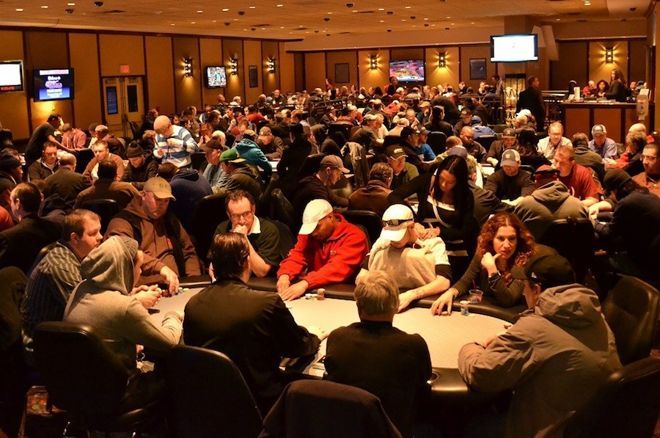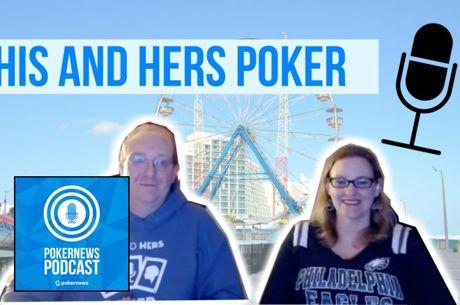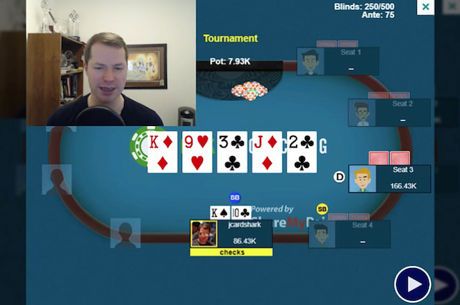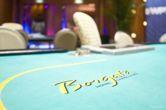His and Hers Poker: Quest for Redemption

Today's hand is a direct sequel to Tracey's hand from Episode #25 of the His and Hers Poker Podcast. In the podcast hand, Tracey attempted to bluff a player off the turn when she had a monster draw. Unfortunately, she got caught and was stacked.
The following occurred only a few orbits later at the same table.
The Table and Villain(s)
We're both at the same $2/$5 table at the Borgata. Tracey is the Hero for this hand.
The primary Villain in the hand is on the button. He is a friendly guy in his late 20s. Matt and Tracey have already mentioned their podcast at the table. Since then, the Villain has been chatting with both of them about strategy. He seems to be a competent player who thinks critically about the game. His main leak thus far has been a tendency to make a few too many curious hero calls.
The player in the cutoff is a loose, passive recreational player who tends to open too wide from late position.
Effective Stacks: ~$900 (Hero).
Preflop
Action
It folds to the cutoff who opens to $20. The Villain calls from the button. Hero is in the small blind and looks down to find A?7?. Hero decides to call. The big blind folds.
Analysis
Tracey's Take: I called because I felt that my ace-high was probably ahead of the cutoff's range since he was opening very wide from that position.
Matt's Take: A?7? is probably not something we want to be calling with from the small blind. Since its drawing potential is almost nonexistent, we're playing this hand to hit a pair. The trouble is that if we hit an ace and encounter resistance, we're often going to be dominated by a higher kicker held by one of the other players. That problem is going to be compounded by the fact that we are out of position.
Flop
Action
With $65 in the pot, the flop comes Q?J?8?. Hero checks and the cutoff checks behind. The Villain bets $40. Hero elects to call and the cutoff folds.
Analysis
You will often see monochrome (all one suit) flops completely check through. There's a reason for that. It's difficult to balance your range on a flop like this. The easy/lazy way to balance a range is to just take one action with everything. As a result, most players just opt to check their whole range on monochrome flops.
Every once in a while, however, you'll see a bet. In our experience, such a bet at a $2/$5 table is almost never a flopped flush. Why? The basic driving force for most low stakes players is greed. They slow play monster hands because they are deathly afraid of revealing their holding and not getting paid off.
So, if someone flopped a flush here (particularly a good flush), the last thing we would expect from that player is a bet. That's probably true even from this decent Villain. That caps his value range at 10x9x for the straight.
In response to Villain's bet, we can either raise or call. The decision is close. Let's look at the factors weighing in both directions.
Raising: We read Villain as never having a flush. If we raise now, we can set up a punishing multi-barrel bluff over all three streets and he'll be hard pressed to continue. We also have the nut-flush blocker with the A?. Thus, even on the off chance he has a flush, it's never the nut flush. We might be able to blast him off something like 7?6? by the river.
Calling: The problem with raising is a question of how Villain will perceive that line. Most $2/$5 players would just call in our spot if they had flopped the nut flush. Therefore, if we want to represent the nut flush with our nut-flush blocker, we should take the line which mimics that holding in Villain's mind. That's probably a call.
Turn
Action
There's $145 in the pot as the turn brings the K?, making the board Q?J?8?K?. Hero checks and Villain bets $85. Hero raises to $250. Villain tanks for about 30 seconds before calling.
Analysis
Our raise punishes what we read as Villain's capped, flush-less range by turning all of his lovely straights, sets, etc. into identical bluff catchers. The raise is completely polarizing. We either have the flush here or we don't. We're never raising with anything less.
So, what should Villain be thinking about when he tank-calls?
If he calls here, it should be primarily based on one thing: having a spade blocker. Most $2/$5 players don't think about blockers, however. Villain (who likes to make hero calls) most likely took 30 seconds to convince himself that Hero could be raising with some value hand that he either beats or has outs against.
River
Action
With $645 in the middle, the river is the J?, making the final board Q?J?8?K?J?. Hero shoves for $600. Villain tanks for three minutes before having the clock called on him. He thinks for the full minute before open mucking his J?10?. He offers to pay Hero $5 to see her cards. Hero joyfully accepts and shows her bluff.
Analysis
The shove here is likely correct as a simple matter of necessity. We just can't win with ace-high. That being said, the J? is an absolutely miserable card for us. A ton of Villain's turn calling range just boated up. The other problem is that we are hard pressed to continue to represent the nut flush here.
After the hand, Matt asked Tracey if she would have shoved if she actually had the nut flush. Tracey responded that she probably would have checked the flush when the board paired. Therein lies the problem. If we were against a very sophisticated opponent who could sniff that fact out, this would probably just be a give-up.
We know that this Villain is a thinking player, but can he make that read? After review, both Tracey and Matt believe that it was worth the gamble that he could not. Also in the mix is the fact that Villain might not be inclined to believe that Hero is making another bluff shove so soon after recently being stacked on a failed bluff attempt.
The Takeaway
Most low stakes players have horribly imbalanced ranges on certain board textures. That makes for a great opportunity to exploit those imbalances with things like the nut flush blocker.
Keep an eye out for similar spots �� where a particular line can mean that a player's range is likely capped to never have a certain premium holding. Also, don't let one failed bluff keep you from running another one right away. Keep the pressure up and get some redemption!
His and Hers Poker is a free, weekly strategy podcast hosted by Matt and Tracey Waldt. They are a married couple who play live cash games on the East Coast. Their podcast focuses on providing practical advice about hand reading, with an emphasis on how to identify and exploit the common leaks and imbalances of low-stakes players. His and Hers Poker can be found on iTunes, Google Play and other podcast services. For more information, and to subscribe, please visit hisandherspoker.com.









